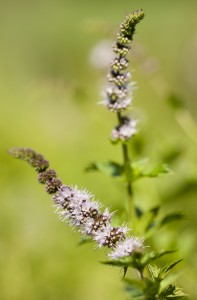“M” is for Mint
Posted in Gardening Tips on August 19 2014, by Sonia Uyterhoeven

In Greek mythology, the goddess Persephone suspected her husband Hades, god of the underworld, of having a tryst with a nymph named Minthe. In a jealous rage, she transformed the lovely nymph into a perennial herb. Hades, unable to counteract his wife’s spell, bestowed Minthe with a sweet smell so that she would continue to delight those who came in contact with her.
Clearly, the aromatic qualities of mint are legendary. Through the centuries, mint has played an important role in many cultures, from the Greeks who rubbed mint leaves on their tables to welcome guests, to India, where it was strewn around temples and homes to clean the air. In the middle east, mint tea is often brought out to greet friends in the home.
Unlike many herbs that prefer sunny, dry spots, mints prefer moist soil in part shade/sun. As many of us know too well from experience, however, they are highly adaptable plants—and that’s putting it mildly. They grow in a wide range of conditions and are only too happy to expand their territory once they are planted in the ground. When I was a kid, my mother planted peppermint behind the vegetable garden; years later, the vegetable garden is gone, but the mint still thrives.
